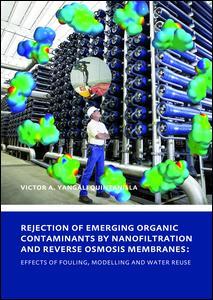Description
Rejection of Emerging Organic Contaminants by Nanofiltration and Reverse Osmosis Membranes
Effects of Fouling, Modelling and Water Reuse
Author: Yangali Quintanilla Victor Augusto
Language: English
Subjects for Rejection of Emerging Organic Contaminants by...:
Keywords
Log Kow; equivalent; NF-200 Membrane; width; RO Membrane; contact; NF90 Membrane; angle; Multiple Linear Regressions; zeta; Salt Rejection; potential; QSAR Model; octanol; NF Membrane; water; QSAR; partition; Molecular Width; coefficient; Van Der Bruggen; BPA; Drinking Water Treatment Plants; ATR FTIR Spectrum; Ann Model; Flux Decline; Linear QSAR; Endocrine Disruption; Neutral Organic Compounds; Doc Concentration; EDCs; MATLAB 2007b; Octanol Water Partition Coefficient; Hydrophilic Neutral; PLS Regression
214.69 €
In Print (Delivery period: 14 days).
Add to cartPublication date: 11-2017
· 17.4x24.6 cm · Hardback
Approximative price 117.69 €
In Print (Delivery period: 14 days).
Add to cartPublication date: 05-2010
216 p. · 17.4x24.6 cm · Paperback
Description
/li>Contents
/li>Readership
/li>Biography
/li>
Pollution of water sources with emerging contaminants (micropollutants) is a fact known worldwide. Although the risks of micropollutants in sources of water are partly recognized, interpretation of consequences are controversial; thus, the future effects of altered water with micropollutants remains uncertain and may constitute a point of concern for human beings when potable water consumption is involved. Therefore, many drinking water utilities target as an important goal high-quality drinking water production to lessen quality considerations that may arise from the consumers. In this thesis, by means of the use of multivariate data analysis techniques, removal quantification is effectively determined and more understanding of the separation of micropollutants by membranes is achieved.




